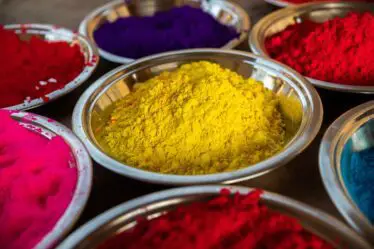
Thai chili peppers, also known as bird’s eye chili peppers, are a staple in Thai cuisine and are known for their intense heat and vibrant flavor. These small peppers originated in South America and were brought to Thailand by Portuguese traders in the 16th century. Since then, they have become an integral part of Thai cooking and are used in a wide variety of dishes.
Thai chili peppers are small, slender peppers that measure about 1-2 inches in length. They are typically green when unripe and turn red as they mature. The peppers have a thin skin and are extremely spicy, with a Scoville heat rating ranging from 50,000 to 100,000 units. Despite their small size, Thai chili peppers pack a punch and can add a fiery kick to any dish.
Key Takeaways
- Thai chili peppers are small but pack a punch in terms of heat and flavor.
- The heat of Thai chili peppers comes from capsaicin, which has been linked to health benefits such as pain relief and improved digestion.
- Thai chili peppers are commonly used in Thai cuisine, but can also be used in a variety of dishes from around the world.
- To store and preserve Thai chili peppers, they can be dried, frozen, or pickled.
- Growing Thai chili peppers at home is easy and can provide a fresh supply for cooking.
The Heat of Thai Chili Peppers
The heat of Thai chili peppers comes from a compound called capsaicin, which is found in the seeds and membranes of the pepper. Capsaicin is responsible for the burning sensation that occurs when you eat spicy foods. It stimulates the nerve endings in your mouth, causing them to send signals to your brain that you are experiencing heat.
In terms of heat, Thai chili peppers are considered to be quite hot. They are significantly spicier than jalapenos but not as hot as habaneros or ghost peppers. The Scoville scale is used to measure the spiciness of chili peppers, with higher numbers indicating hotter peppers. Thai chili peppers typically range from 50,000 to 100,000 Scoville heat units, making them one of the spicier varieties of chili peppers.
Health Benefits of Thai Chili Peppers
In addition to adding flavor and heat to dishes, Thai chili peppers also offer several health benefits. They are low in calories and fat but high in vitamins A and C, as well as potassium and antioxidants. These nutrients can help boost the immune system, promote healthy skin, and support overall well-being.
Capsaicin, the compound responsible for the spiciness of Thai chili peppers, has also been found to have several health benefits. It has been shown to have pain-relieving properties and is often used in topical creams and ointments for conditions such as arthritis and muscle pain. Capsaicin may also help improve digestion by increasing blood flow to the stomach and promoting the release of digestive enzymes.
Culinary Uses of Thai Chili Peppers
| Culinary Uses of Thai Chili Peppers | Description |
|---|---|
| Spice Level | Thai chili peppers are known for their high spice level, ranging from 50,000 to 100,000 Scoville units. |
| Curries | Thai chili peppers are a common ingredient in Thai curries, adding heat and flavor to the dish. |
| Sauces | Thai chili peppers are often used to make spicy dipping sauces, such as nam prik. |
| Stir-Fries | Thai chili peppers are a popular ingredient in stir-fries, adding heat and flavor to the dish. |
| Soups | Thai chili peppers are often used to add spice to soups, such as tom yum. |
| Salads | Thai chili peppers are sometimes used in Thai salads, such as som tam, to add heat and flavor. |
Thai chili peppers are a key ingredient in Thai cuisine and are used in a wide variety of dishes. They add heat and flavor to soups, stir-fries, curries, and sauces. Thai chili peppers are often used in combination with other ingredients such as garlic, ginger, lemongrass, and fish sauce to create complex and aromatic flavors.
One popular Thai dish that uses Thai chili peppers is Tom Yum soup. This spicy and sour soup is made with a flavorful broth infused with lemongrass, kaffir lime leaves, galangal, and Thai chili peppers. The heat from the chili peppers adds a fiery kick to the soup, while the other ingredients balance out the flavors.
Another popular Thai dish that features Thai chili peppers is Pad Thai. This stir-fried noodle dish is made with rice noodles, shrimp or chicken, bean sprouts, eggs, and a tangy sauce made from tamarind paste, fish sauce, sugar, and Thai chili peppers. The chili peppers add heat and depth of flavor to the dish, making it a favorite among spice lovers.
How to Store and Preserve Thai Chili Peppers
To store fresh Thai chili peppers, it is best to keep them in a cool, dry place away from direct sunlight. You can store them in a paper bag or airtight container to help extend their shelf life. If you have a large quantity of Thai chili peppers, you can also freeze them for later use. Simply wash and dry the peppers, then place them in a freezer bag or container and store them in the freezer.
If you want to preserve Thai chili peppers for an extended period of time, you can also dry them. To do this, simply string the peppers together using a needle and thread, then hang them in a well-ventilated area until they are completely dry. Once dried, you can store them in an airtight container and use them as needed.
Growing Thai Chili Peppers at Home

If you enjoy cooking with Thai chili peppers, you may want to consider growing your own at home. Thai chili pepper plants are relatively easy to grow and can be grown in containers or in the ground. Here is a step-by-step guide to growing Thai chili peppers at home:
1. Choose a sunny location: Thai chili pepper plants thrive in full sun, so choose a location that receives at least 6-8 hours of direct sunlight per day.
2. Prepare the soil: Thai chili pepper plants prefer well-draining soil that is rich in organic matter. Amend the soil with compost or well-rotted manure before planting.
3. Plant the seeds or seedlings: You can start Thai chili pepper plants from seeds or purchase seedlings from a nursery. If starting from seeds, sow them indoors 8-10 weeks before the last frost date. Transplant the seedlings outdoors once all danger of frost has passed.
4. Water regularly: Thai chili pepper plants require regular watering to keep the soil evenly moist. Water deeply once or twice a week, depending on weather conditions.
5. Fertilize regularly: Feed your Thai chili pepper plants with a balanced fertilizer every 4-6 weeks during the growing season to promote healthy growth and fruit production.
6. Harvest the peppers: Thai chili peppers can be harvested when they are green or left on the plant to ripen to red. Simply snip the peppers off the plant using a pair of scissors or pruning shears.
Thai Chili Pepper Varieties and Scoville Scale
There are several different varieties of Thai chili peppers, each with its own unique flavor and level of spiciness. Some of the most common varieties include:
– Bird’s Eye Chili: This is the most common variety of Thai chili pepper and is known for its intense heat and fruity flavor.
– Prik Kee Noo: Also known as “mouse dropping chili,” this variety is slightly milder than bird’s eye chili but still packs a punch.
– Prik Chee Fah: This variety is larger and milder than bird’s eye chili, making it a good choice for those who prefer less heat.
The Scoville scale is used to measure the spiciness of chili peppers. It assigns a numerical value to each pepper based on its capsaicin content. Thai chili peppers typically range from 50,000 to 100,000 Scoville heat units, making them quite hot compared to other chili peppers. For comparison, jalapenos typically range from 2,500 to 8,000 Scoville heat units, while habaneros can range from 100,000 to 350,000 Scoville heat units.
Thai Chili Pepper Recipes to Try
If you’re looking to incorporate Thai chili peppers into your cooking, here are a few recipes to try:
1. Thai Basil Chicken:
– Heat oil in a wok or skillet over high heat.
– Add minced garlic and Thai chili peppers and stir-fry for 1 minute.
– Add ground chicken and cook until browned.
– Stir in soy sauce, fish sauce, sugar, and Thai basil leaves.
– Cook for another 2-3 minutes, until the sauce has thickened.
– Serve over steamed rice.
2. Green Curry:
– Heat oil in a large pot over medium heat.
– Add green curry paste and cook for 1 minute.
– Add coconut milk, chicken or vegetables, and Thai chili peppers.
– Simmer for 10-15 minutes, until the chicken is cooked through or the vegetables are tender.
– Stir in fish sauce, sugar, and lime juice.
– Serve over rice or noodles.
3. Spicy Thai Noodle Salad:
– Cook rice noodles according to package instructions.
– In a large bowl, combine sliced cucumbers, shredded carrots, chopped cilantro, and Thai chili peppers.
– In a small bowl, whisk together lime juice, fish sauce, sugar, and minced garlic.
– Toss the cooked noodles with the dressing and vegetables.
– Serve chilled as a refreshing and spicy salad.
Pairing Thai Chili Peppers with Other Ingredients
Thai chili peppers pair well with a variety of ingredients and can add heat and flavor to many dishes. Here are a few suggestions for ingredients that go well with Thai chili peppers:
– Garlic: The combination of garlic and Thai chili peppers adds depth of flavor and heat to dishes.
– Ginger: Ginger adds a spicy and aromatic element to dishes when combined with Thai chili peppers.
– Lemongrass: Lemongrass has a citrusy flavor that complements the heat of Thai chili peppers.
– Fish sauce: Fish sauce adds a savory umami flavor to dishes and pairs well with the spiciness of Thai chili peppers.
Some examples of dishes that use Thai chili peppers in combination with other ingredients include green curry, Tom Yum soup, and Pad Thai.
Adding Thai Chili Peppers to Your Spice Collection
Thai chili peppers are a versatile ingredient that can add heat and flavor to a wide variety of dishes. Whether you enjoy spicy food or are looking to experiment with new flavors, Thai chili peppers are a great addition to your spice collection. They offer several health benefits, including pain relief and improved digestion, and can be used in both savory and sweet dishes.
So why not give Thai chili peppers a try? Whether you’re cooking up a spicy stir-fry or adding a kick to your favorite soup, Thai chili peppers are sure to add a fiery punch to your culinary creations. So go ahead, spice up your life with Thai chili peppers!
If you’re a fan of the fiery heat of hot Thai chili peppers, you might also be interested in learning about the delightful world of Cotton Candy Grapes. These unique grapes have a distinct flavor that resembles the sweet and fluffy treat we all know and love. Discover more about these delicious grapes and how they are grown in this fascinating article on Flavorful Sips: All About Cotton Candy Grapes.



